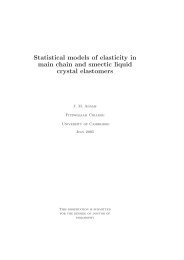Sandra Hopkins Final Report.pdf - University of Surrey
Sandra Hopkins Final Report.pdf - University of Surrey
Sandra Hopkins Final Report.pdf - University of Surrey
You also want an ePaper? Increase the reach of your titles
YUMPU automatically turns print PDFs into web optimized ePapers that Google loves.
couch height position when the centre <strong>of</strong> the heart is positioned at the isocentre. Siemens apply atolerance <strong>of</strong> +/-30% to this but it is known that greater accuracy can be achieved.2.6 Patient Dose RecordFor every examination, on the Siemens Axiom Artis, there is a patient dose record. This providesinformation on every acquisition run including the field size, skin dose in mGy, Dose Area Product,amount <strong>of</strong> copper in the beam, frame rate and tube orientation. Fluoroscopy runs are not recordedindividually. However at the end <strong>of</strong> the dose record the total dose is recorded and from this theproportion <strong>of</strong> dose as a result <strong>of</strong> fluoroscopy can be calculated by subtracting the total accumulateddose from the individual acquisition runs. Appendix A shows an example patient dose record.2.7 Gafchromic filmIt is possible to get a visible indication <strong>of</strong> skin dose distribution by using film. Large films withslow x-ray response are required (doses are too high to use conventional diagnostic imaging film forthis technique) 29, 30, 31 although common resin coated photographic paper has also been consideredas an alternative 32 . Kodak EDR2 film, which was originally used for portal imaging andradiotherapy has been used for skin dosimetry 33, 34, 35 . There are limitations to using this film since itsaturates at 1 to 1.5Gy which means it may not be adequate for high dose interventional cardiology.In addition, the requirement for wet processing can be time consuming and cumbersome.Gafchromic film does not saturate at higher radiation doses and does not require processing.Currently Gafchromic film is too expensive to use routinely for patient skin dose mapping but it is auseful tool to provide an immediate visual indication <strong>of</strong> the dose distribution 36, . The films developby changing colour from their original orange to a grey level which becomes progressively darkerin proportion to absorbed dose. The active component in radiochromic dosimetry film is a longchain fatty acid, which when exposed to radiation, active diacetylenes are polymerised to producepolydiacetylene which result in the distinctive colour change. Variations in construction provide fordifferent sensitivities <strong>of</strong> Gafchromic film. That used in this case is XR Type R dosimetry film. Theresponse <strong>of</strong> the film from 80kVp to 120 kVp x-rays is energy independent and is also dose rateindependent. XR Type R dosimetry film can be handled in normal room light for several dayswithout noticeable effects. The quoted acceptable dose range for this film is from 0.1 Gy to 1.5 Gy.2.8 Thermoluminescence and Thermo Luminescent DosimetersThere are many theoretical models to describe thermoluminescence but none can completelydescribe the complex mechanism in specific substances. However, a general theoretical mechanismhas been described with reference to the crystal structure <strong>of</strong> the alkali halides. All crystals contain11
















